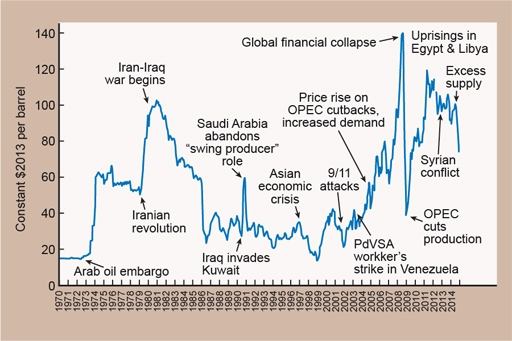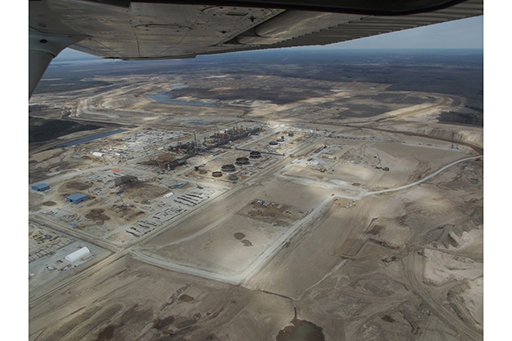3.12 Economics of oil production
Oil production and use drives a huge amount of the global economy, and, in turn, it is economic factors that drive a lot of oil production and exploration. Finding new supplies of oil is expensive: commissioning and interpreting large seismic surveys; drilling test wells; paying governments for the right to explore in their territory; and putting in place infrastructure to extract, refine and transport oil all costs vast sums of money.
The price of oil changes with supply and demand, and can fluctuate wildly in times of global economic crisis and war. As increasing oil production and finding new oil reserves takes time, increases in demand (during an economic boom) will drive steep increases in the price of oil. Some proportion is also politically controlled, with consortiums like OPEC (Organization of the Petroleum Exporting Countries) acting to restrict or increase oil supply to stabilise and manage the oil price.

The oil that is ‘easy’ to find and extract is also beginning to dwindle. As you learned at the start of this week, early oil discoveries were from places where oil was seeping out of the ground. Days of such easy oil discoveries are now (mostly) long gone. Decades of production also means that some large oil fields are beginning to run dry. New oil extraction is therefore increasingly being made in more difficult and expensive places, like the deep sea and polar regions. As the oil price increases, these more expensive-to-extract reserves of oil become economically viable. At times when the price of oil is high, smaller pockets of oil in larger oil fields also become viable. As Dr Bell said in the video about seismic exploration, this is why it’s important to know how much oil is present in any reservoir before attempting to extract it. Modern 3D seismic surveys and advances in drilling technology to extract the oil make it more feasible for smaller reserves to be extracted, but it’s still expensive, and relies on a high oil price to make small oil reservoirs possible.
Unconventional oil
High oil prices also make expensive-to-produce ‘unconventional oils’ economically viable. These unconventional oils aren’t like the normal oil reserves described so far.
Oil sands
Oil sands (or tar sands) are formed where oil formed at depth (in the same way as described above) reaches the near surface and becomes trapped in sands. Near-surface exposure of the oil means it begins to degrade as it reacts with oxygen, and the smaller, lighter hydrocarbon molecules are preferentially lost. Oil in oil sands are therefore usually very viscous, and very difficult (and dirty) to extract and process. As they are found at the surface and the oil is so thick that it can’t be pumped out like in a normal oil reservoir, huge amounts of oil-rich sand are mined and treated chemically and thermally to remove the oil.
In areas where the sands are too deep to dig out, large amounts of steam and carbon dioxide are pumped into the sands until the oil is made runny enough to pump out.
Both processes are hugely energy and resource intensive, and are therefore hugely expensive, even compared to normal oil extraction. Oil sands have only recently been made economically viable in large quantities due to the high oil price, and are now extracted extensively in parts of Canada.
The mining and extraction processes do also produce large amounts of chemical and water waste, and the strip mining of sands destroys habitats, so it’s generally thought of as one of the dirtiest ways of getting oils.
Shale oil
Oil shales are organic rich, fine grained rocks. With significant chemical and thermal treatment, the organic matter within the oil shales can be converted to synthetic oil. This is effectively shortcutting the process which produces conventional oil, as oil shales would make very good source rocks.
There are vast quantities of oil shale on earth – enough in the USA alone to produce 2 trillion barrels of oil. But the high energy costs in extracting the oil mean that it is only a minor source of oil today, and will likely stay that way for some time.

